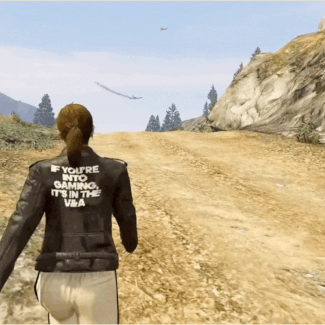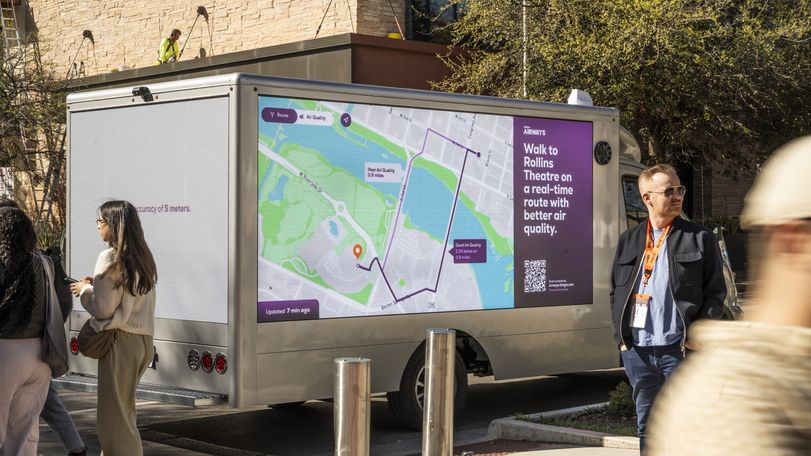
question of the week
Guerrilla marketing: a playful adversary to AI-personalised ads
Our lives are filled with algorithmic personalised digital marketing, now exacerbated by AI - does guerrilla marketing offer something more playful, charming and meaningful?
18 April 2024
While ‘guerrilla marketing’ may have been more popular in the late 20th century, and there have been less and less campaigns of the like in the last few years, some recent examples point to their undying power and potency - especially in 2024.
Just last month, adam&eveDDB hid messages on several uniquely special objects to promote V&A. A century-old silver tankard was engraved with a message about the museum and buried in a popular Oxfordshire metal-detecting location. A handmade 2-metre-long battle flag was also displayed by an armoured participant for a battle reenactment group.
The “If you’re into it, it’s in the V&A” campaign aimed to drive mass re-appraisal and tap into people’s niche passions –from punk to pottery, or stamps to streetwear. The guerrilla-style work creatively highlighted the breadth of V&A’s permanent collection of over 2.8 million objects, which tell a 5,000 year old story of creativity in themselves.
Not only this, but in a similar vein, the agency also created a campaign for Marmite, recruiting lovers (and not haters) of the yeast extract to smuggle jars into the US which has little to no access to Marmite. In the UK, phone kiosks and poster sites were plastered with the recruitment messages, and on the radio a distorted voice called for Brits to smuggle the spread to the thousands of expats who needed a fix.
Perhaps, out of the AI boom and ever-increasing levels of personalised digital marketing, the more charming, playful and meaningful form of guerrilla marketing has returned to drive genuine emotional engagement - not just skip this ad. The serendipity of discovering a hidden or unsuspecting ad as opposed to being presented with many campaigns digitally is arguably more personal than ‘personalised’ marketing itself, especially in an age packed full of technologies that are built to maintain your attention.
So, is there a beauty to guerrilla marketing? Is it really back for good (not to quote Take That)? And does guerrilla marketing still hold relevance in the 2020s? We ask the industry’s best.
Mark Shanley, creative director, adam&eveDDB
Let’s be honest. We ignore advertising. It’s what we do. Even you, advertising person, reading this right now. You ignore advertising. You ignore it when it interrupts your TV or streaming. When it interrupts your social network scrolling. You ignore it in the pages of your magazines and newspapers. On the radio. And you routinely ignore advertising on the streets in posters, large and small. As a society we’ve gotten very good at ignoring advertising.
But it’s much harder to ignore something you didn’t see coming. Something a bit surprising. Something tactile in a digital world. The reason we favoured it for the V&A campaign is for its ability to talk directly to you at a moment when you’re engaging with something you really care about. And guerrilla advertising is much harder to ignore because it doesn’t look like advertising. The best advertising doesn’t look like advertising.
David Bain, co-founder and chair, BMB
“Guerrilla”. It’s such a curious marketing ‘war word’. If I knew anything about Napoleon’s Peninsular Campaign (1807-1814), I might remark on the word’s origins as descriptive of the ‘little wars’ fought against the French long ago. But I don’t, so I won't.
What interests me more is the prospect that ambush, stealth, and surprise might be making a return to the vocabulary of advertising. By its nature most advertising today is primarily driven by predictability and relevance. Digital marketing is built on the science of predicting who you are, what interests you, and where you might be on an imagined purchase funnel. Its watchwords are ‘no alarms and no surprises’, just relevant and timely messages that nudge towards action.
Any resurgence in ‘guerrilla’ marketing might point us to a new truth and a new opportunity- it reminds us that creative surprise still matters. But also perhaps that it can no longer just be a matter of message (saying something surprising) or manner (saying it in a surprising way). In the jaded, exhausted ad saturated now, real creative surprise will be about where and through what means we say things. We need invention not just creativity, ideas that build their own mediums not just occupy them.
Dan Bailey and Brad Woolf, creative directors, New Commercial Arts
To paraphrase the immortal words of LL Cool J, ‘Don’t call it a comeback, it’s been here for years.’ If not for some brilliant guerrilla thinking, how else would Burger King have got Messi to wear their logo and put in a 90-minute shift for Stevenage? Even if was ‘just’ on FIFA 20.
And if you popped out to Sainsbury’s this morning and were confronted by a gallery of Old Masters, you’d have been stopped in your tracks. Just as you would have been when the National Gallery & Hewlett Packard put on their Grand Tour in 2008.
The lovely work for the V&A has shown what we already know to be true. The secret, which is no secret at all, is that the idea has to justify the means. When we know people are already seeing thousands of ads a day, squeezing another one in front of them only increases the obligation for us to be interesting. Of course, the use of data, algorithms and personalised marketing can make our work more effective. But will it ever successfully persuade gamers and galacticos alike to proudly choose Stevenage over Barcelona?
Manuel Frank, global creative chair for health, Edelman
I believe guerrilla tactics still hold relevance today – and with just under 40 per cent of internet users around the world using ad blocking technology in some form – maybe even more so than in the past. As a creative in an agency, I love the challenge of creating surprise and delight in a real moment in the real world. And as a consumer I appreciate brands charming me with the power of creativity instead of “outsmarting” me in my social networks.
Just a few weeks ago at SXSW we offered attendees an experience that was too good to say no to. For our client Allegra we had the opportunity to develop Allegra Airways, a first of its kind navigation tool that harnesses real-time pollen and air pollution data to serve up routes with cleaner air to breathe. While clearly a game changer for allergy sufferers, explaining the tool will always fall short of experiencing it. So we “hacked” something that Austin loves around SXSW: Pedicab rides! We mixed a small Allegra Airways fleet into the roundabout 500 pedicabs that are used daily for the festival. Equipped with iPads, passengers could calculate their routes and breathe better air while getting from A to B for free.









